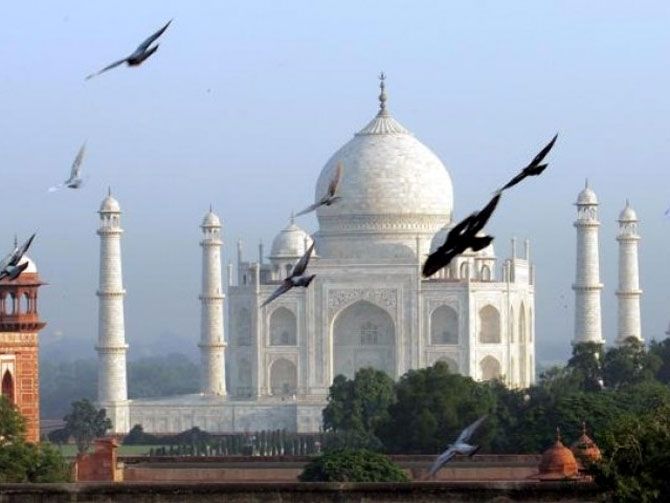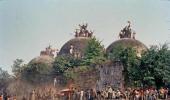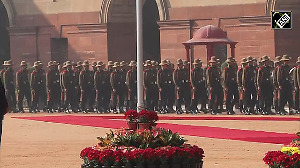How much do you know about Shah Jahan, Mumtaz Mahal and the Taj Mahal?

Setting off a controversy comes naturally to Sangeet Som, the Bharatiya Janata Party legislator from Sardhana, Uttar Pradesh.
On Monday, October 16, Som targeted the Taj Mahal, the 17th century monument which is the stellar attraction for tourists visiting India.
'Is this history that the person who built the Taj Mahal imprisoned his father? Do you call it history when the one who built the Taj targeted many Hindus in Uttar Pradesh and Hindustan?' Som thundered at a political rally.
'The blots which are in our books, be it of Akbar, Aurangzeb, Babur... The government is working to remove them from history,' Som added.
After a predictable controversy erupted, Som clarified: 'I don't oppose the Taj Mahal. It's a beautiful heritage. I oppose the Mughals who built it and how they've been portrayed in history.'
But what is the truth about the Taj Mahal?
Who built it?
What was Shah Jahan like as an emperor? Did he really jail his father, as Som says?
Rediff.com's Syed Firdaus Ashraf revisits an era from India's history to locate the truth.
So, who was Shah Jahan?
Shah Jahan was Mughal emperor Jehangir's son and Akbar's grandson.
He was born on January 15, 1592 in Lahore to the Rajput princess Jagat Gossain, also called Jodh Bai, whose father was Uday Singh Rathor of Marwar.
On the sixth day of his birth, the child was named Khurram (Joyous) by Akbar, and was handed over to Ruqaiya Begum -- Akbar's childless wife -- who became his foster mother when the little prince was four years, four months and four days old.
When did he marry Mumtaz Mahal?
In 1607, when Shah Jahan was 16, he married Arjumand Banu Begum aka Mumtaz Mahal.
Mumtaz was a Persian, like Hamida Banu Begum, one of Akbar's wives, and Nur Jahan, Jehangir's best-known wife.
Was Mumtaz Mahal his only wife?
No. Shah Jahan had two other wives. However, their children did not survive. Only Mumtaz Mahal gave him an heir.
Seven of the royal couple's children survived, four boys and three girls: Jahanara Begum, Dara Shikoh, Shah Shuja, Raushanara Begum, Aurangzeb, Murad Bakhsh and Goharara Begum.
When did he become emperor?
On February 6, 1628, Shah Jahan was crowned emperor. He ruled till 1658.
Gold and silver were given away to charity during his coronation.
Mumtaz Mahal was presented with 2 lakh ashrafis. Her annual allowance was 1 million rupees.
Did he imprison his father Jehangir, as Sangeet Som claims?
Shah Jahan went to war against Jehangir, was defeated and was imprisoned.
Jehangir later took pity on his son and released him from prison.
After Jehangir's death his wife Nur Jahan passed on the baton briefly to Jehangir's other son, Shahryar, and not Shah Jahan.
Shah Jahan took Shahryar on in battle and killed him. He also killed his other brothers, Dawar Bakhsh and Garshasp.
Shah Jahan took ill in 1657 and shortly thereafter declared his eldest son, Dara Shikoh, as his successor.
This was contested by his other sons and a battle broke out with the emperor too unwell to prevent it.
At the end of the bloody campaign, Aurangzeb triumphed. His brothers were dead.
After he declared himself emperor, Aurangzeb kept Shah Jahan under house arrest till his father's death in 1666.
In what language did Shah Jahan conduct court business?
Shah Jahan conducted his business in Persian. He was the first Mughal emperor who did not learn Turkish like his predecessors had done.
Unlike his father Jehangir and grandfather Akbar, Shah Jahan did not encourage a biography to be written about him.
When did Mumtaz Mahal die?
Mumtaz Mahal died on June 17, 1631 while giving birth to her 14th child, Goharara Begum.
Devastated by his wife's death, the emperor withdrew from public life for a week.
'Nobody's face can delight me now,' Shah Jahan is reported to have said.
Was Mumtaz Mahal buried in Agra where the Taj Mahal is situated?
No. Mumtaz Mahal was buried at Burhanpur on the banks of the Tapti river.
Six months later, her body was exhumed and she was re-interred on January 8, 1632, on the banks of the Yamuna where the Taj Mahal was built.
Initially, Shah Jahan called her tomb the Rauza-i-Munavvara (the illumined tomb).
It was later called Mumtaz Mahal, then the Taj Mahal.
Is the Taj Mahal the only monument Shah Jahan built?
The emperor built the Jama Masjid in Delhi, commissioned the Peacock Throne, the most opulent throne of its time.
The Red Fort of Delhi, the Pearl mosque in Agra, the Tatta mosque in Sind, the Shalimar Bagh in Lahore were all built in his time.
Who was the architect of the Taj Mahal?
37 creative minds worked on the design on the Taj Mahal.
20,000 labourers toiled day and night from 1631 to 1654.
Ustad Isa -- a Turk who either came from Constantinople (today's Istanbul) or from Shiraz or Isfahan in Persia -- is usually credited as the Taj's architect.
Some say the actual architect was a Persian named Ahmed. Again, there is no proof of this.
So, yes, Sangeet Som is right -- the men behind the Taj's design were foreigners.
And what about the other artisans involved?
From Turkey came Ismail Afandi, a designer of hemispheres and a builder of domes.
To oversee the finances and the daily supervision of work on the site, the emperor chose Abdul Kari and Mukarrimat Khan, seasoned administrators from Shiraz, Persia.
Master calligrapher Amanat Khan -- whose name is located at the base of the Taj's interior dome near the lines from the Quran -- was also a native of Shiraz.
The lines, by the way, read, 'Written by the insignificant being, Amanat Khan Shirazi.'
Was any Hindu involved in the Taj's construction or design?
Chiranji Lal, a resident of Delhi, was chosen for his ability to cut gems. He was the Taj's chief mosaicist, the man who created the mosaic for the monument.
Was Shah Jahan cruel towards Hindus?
Though he did not impose jiziya on the Hindus -- the practice was abolished by Akbar -- Shah Jahan, an orthodox Sunni Muslim, was harsh towards Hindus.
Did Shah Jahan demolish Hindu temples?
According to Abraham Eraly's book, Emperors of the Peacock Throne, '76 temples were destroyed in Benares and so were many churches in Agra.'
'Shah Jahan also prohibited Muslims from changing their religion but encouraged conversions to Islam by offering stipends and other favours to converts,' Eraly writes.
Eraly quotes Abdul Hamid Lahori, who wrote Padshanama during Shah Jahan's time and notes, 'Shah Jahan also issued an order that if a Hindu had a Muslim wife he could keep her only if he became a Muslim, otherwise he was to be fined and his wife separated.'
'He also directed that Hindus should keep to their own style of dress, tying their tunics on the left, unlike Muslims, who tied it on the right. Further Hindus were asked to discontinue practices which were offensive to Islam, such as the sale of alcohol, the cremation of the dead of the performance of sati near a Muslim cemetery.'
'He only mellowed down in final years of his reign and that too under the influence of his son, Dara Shikoh, and he presented a stone railing to the great temple built in Mathura by Bir Singh.'
Has anyone wanted to demolish the Taj Mahal?
Lord William Bentinck, a governor general of India, planned to demolish the Taj Mahal and remove its marble.
According to David Carroll in the book The Taj Mahal, 'Bentick intended to ship to London the broken up marble pieces of the Taj Mahal to British aristocrats.'
Why didn't he do it?
Before demolishing the Taj, Bentinck had stripped the marble on the Red Fort and shipped it to England; part of the shipment included pieces of marble for King George IV.
Luckily for India, when the marble from the Red Fort was auctioned in London, the auction was an utter failure.
News of this financial disaster traveled from England to Agra just as Bentinck's men were lurking around in the gardens around the Taj.
Bentinck abandoned his plan as unlucrative and the Taj lived on, enthralling millions of awestruck visitors over the past century and a half.
How did the Taj get its glory back?
Gratitude is due to the unlikely persona of George Nathaniel Curzon, viceroy of India from 1899 to 1905.
Much pilloried for partioning Bengal before he left India in 1905, the famously pompous Curzon ('My name is George Nathaniel Curzon,' went a Balliol rhyme of that time,'I am a most superior person/My cheeks are pink, my hair is sleek/I dine at Blenheim twice a week)' adored the Taj and had it restored to what we see today.
The viceroy ordered that the Taj's dingy marble walls be polished till they glistened.
The stone channels were dug out, flower beds and avenues of trees were replanted, water from the Yamuna was circulated through the fountains.
In Curzon's words: 'No longer approached through dust wastes and squalid bazaars. A beautiful park takes their place; and the group of mosques and tombs, the arcaded streets and the grassy courts that precede the main buildings, are once more as nearly as possible what they were when completed by the masons of Shah Jahan.'
'Every building in the garden enclosure of the Taj has been scrupulously repaired and the discovery of old plans has enabled us to restore the water channels and flower beds in the garden more exactly to their original state.'
Any final words?
The Taliban blew up the Bamiyan Buddhas in March 2001.
ISIS thugs destroyed Palmyra's most treasured artefacts, including the 2,000-year-old Temple of Bel and the Arch of Triumph.
One hopes that horrific fate is not visited on Mumtaz Mahal's mausoleum which Rabindranath Tagore called 'a solitary tear suspended on the cheek of time'.
Photograph: Reuters










